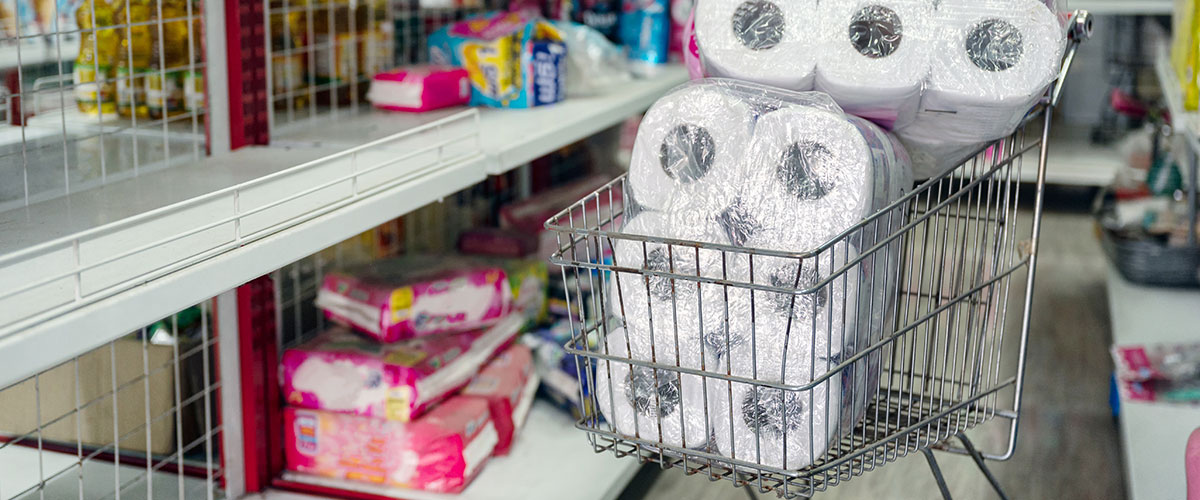How Companies Can Break the Hoarding Habit

Corporations, in a bid to meet consumer demand, are now following the same hoarding trends that consumers practiced at the beginning of the pandemic.
A potent reminder of the insecurities associated with Covid-19 is the hoarding of toilet paper by consumers during the early days of the pandemic. We are now witnessing a corporate version of this practice, as supermarkets build inventories in anticipation of product shortages.
The motivations are different, but the outcome is similar — more acute and longer-lasting shortages. A silver lining is that the lessons learned could lead to more flexible approaches to inventory management generally.
Hoarding is a corporate problem, too
Another manifestation of the hoarding mentality is consumers’ reaction to recent gasoline shortages resulting from the Continental pipeline disruption. Rising demand and a scarcity of tanker truck drivers contributed to the shortage. In response, many consumers decided not to wait until their gas tanks were empty to refuel, choosing instead to regularly top up their partially filled tanks for fear of running out of gas.
This knee-jerk reaction exacerbated the shortages and prolonged the pain for buyers.
Supermarkets are now stockpiling product out of fear that they will be unable to meet rising demand for items that could become pricier. As the Wall Street Journal reported recently, the retailers are intent on keeping costs down and protecting their margins.
Associated Wholesale Grocers Inc. CEO David Smith said:
“We’re buying a lot of everything. Our inventories are up significantly over the same period last year.”
However, their indiscriminate stockpiling is aggravating the shortages issues and straining consumer goods supply chains already under pressure from increasing labor and transportation costs.
The situation is a version of the so-called “tragedy of the commons” economics problem, where actions that make economic sense individually create societal crises.
It may be somewhat surprising that companies are susceptible to this type of short-term, me-first thinking, given that they are more sophisticated predictors of commercial trends than consumers. But such behavior is by no means confined to supermarkets. Recall how in 2001 leading tech companies — notably Cisco — had to write off billions of dollars of excess inventory after falling victim to an overhyped market for high-tech goods.
Root causes and remedies
Part of the problem is that demand forecasting is notoriously error-prone, even with modern-day enhancements such as the use of artificial intelligence and machine learning. Given these challenges, how can companies avoid damaging, knee-jerk reactions to sudden supply/demand imbalances?
Taking an expansive view of the forces that buffet supply chains and the competitive environment in which they operate can help to inoculate companies against short-term decisions that make matters worse. Scenario planning helps to prepare companies for supply shocks. Learning from past disruptions is another way to develop a wider market perspective.
For example, as the Wall Street Journal reports, Toyota has managed to avoid some of the pain that automakers are now experiencing as a result of chronic shortages of microprocessor chips. The company learned some critical lessons about chip supply following Japan’s 2011 earthquake. After digesting these lessons, the company built a stockpile of chips long before the current shortages emerged.
On the surface, it seems that Toyota is guilty of the short-termism that supermarkets are now exhibiting with their stockpiling actions. Like the supermarkets, Toyota stockpiled items in anticipation of shortages.
However, the automaker’s reaction is different in one crucial respect: It is the result of a careful review of long-term market dynamics rather than a knee-jerk decision to build inventory. The 2011 earthquake disaster prompted the company to review its supply needs through a wide market lens.
Toyota realized that supplies of semiconductors are slow to adjust to increases in demand or supply shortages, leading it to the conclusion that for this item, extra inventories are appropriate. Note that Toyota did not change its basic just-in-time philosophy for most items, but the analysis of a single item caused it to adjust.
The strategy is also notable for the fact that Toyota is the high priest of Lean, yet it moved away from the just-in-time philosophy it originated to build its chip inventory.
This departure represents another key defense against the damage inflicted by short-termism: a flexible approach to inventory management that is not hamstrung by dogma. Toyota was willing to become a Lean heretic to protect itself against the threat of a supply shortage that could cripple its production lines.
Keep an open mind
Supermarkets would do well to keep this in mind as they navigate today’s volatile commercial landscape. Disruptors that are driving supply/demand imbalances such as skyrocketing house prices that crimp consumer spending power, rising transportation costs, and rebounding consumer demand, are likely to decline. Thus, supermarkets may want to decide which items to stock up — possibly consumer necessities, or high-margin items — depending on their corporate culture and other competitive factors.
In time, other market disruptors will no doubt take the place of the ones that supermarkets are now grappling with. However, when managing inventory, it is important to keep an eye on the long game rather than merely reacting to the moment and to consider all the options and not just accepted wisdom.
About the Author
Dr. Yossi Sheffi is a professor at the Massachusetts Institute of Technology, where he serves as Director of the MIT Center for Transportation and Logistics (MIT CTL). He is an expert in systems optimization, risk analysis, and supply chain management, which are the subjects he teaches and researches at MIT.
Supply Chain Education Resources
Supply Chain 24/7 Education Resource Center
Find the latest educational resources, degrees, and programs.
Visit: Supply Chain 24/7 Education Resource Center
Related Article: Fulfilling Orders When You Don’t Have Enough Product to Meet Demand













